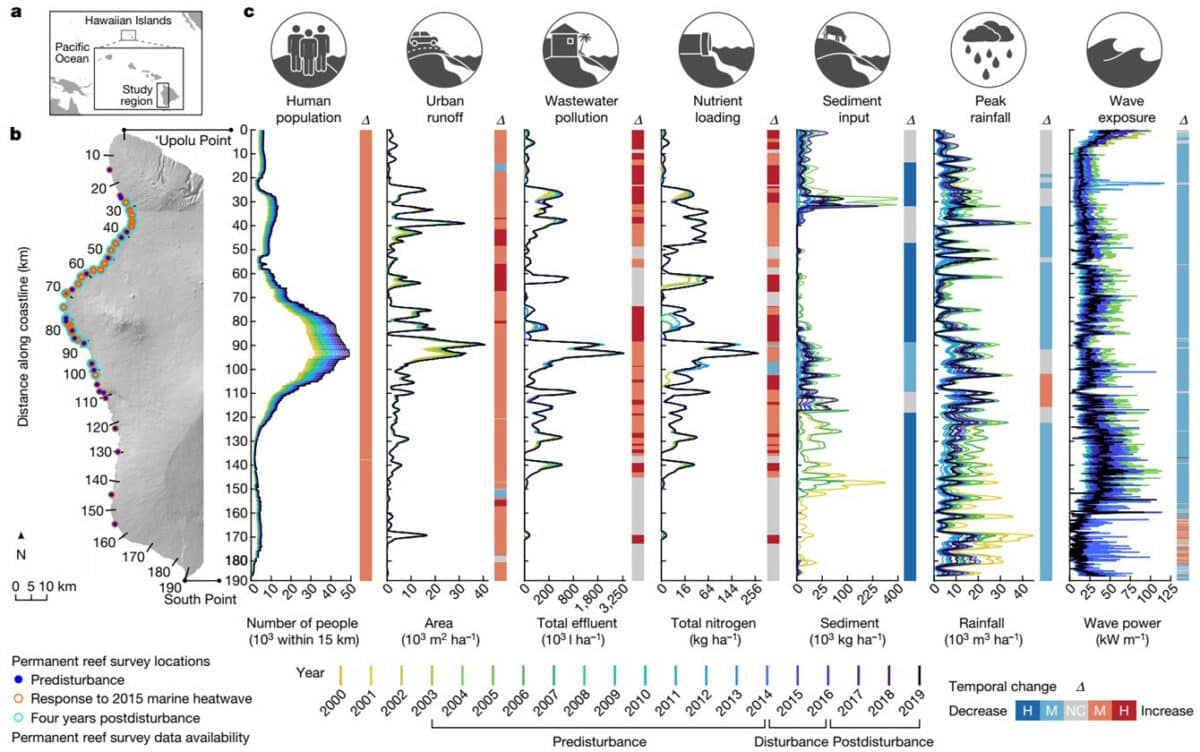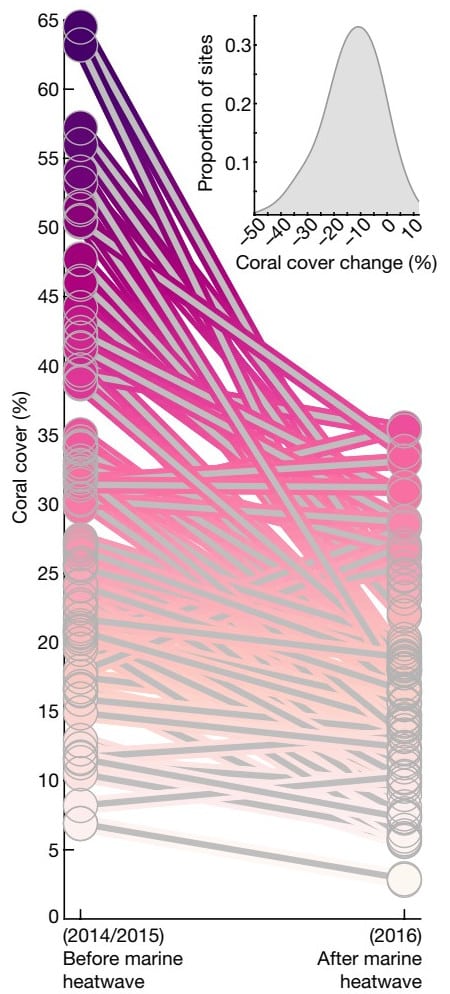Could reducing human impacts in land and at sea help coral reefs during heat waves?

Human population density along the coast is a poor indicator of human-driven land–sea impacts on coral reefs at local scales. Does that surprise you? And yet it’s true. However, urban runoff, wastewater pollution and sediment input do have an impact on coral reef growth and recovery from bleaching events. This is what the team led by Dr. Jamison Gove and Dr. Gareth Williams has shown by monitoring Hawaiian reefs for 20 years.
Background
Hawaiian researchers, led by Dr. Jamison Gove and Dr. Gareth Williams, monitored several biological parameters of Hawaiian coral reefs between 2000 and 2019. In parallel with this monitoring, they measured terrestrial factors known to have impacts on coral reefs, such as wastewater pollution, sediment input, urban runoff, among others. In 2015, a very strong marine heatwave led to the bleaching and then death of many corals. Researchers were able to compare the growth and health of different reefs before, during and after a severe marine heatwave, and the link between reef condition and different levels of human land-sea pressure. They have published their findings in a scientific article in Nature.
Before the 2015 marine heatwave (pre disturbance)
The Hawaiian coral reefs in the study are subject to fairly similar weather and wave conditions (Figure 1). However, human influences vary. Human population density is uneven (Figure 1), but has increased evenly over the years. Urban runoff, wastewater pollution, sediment input and nutrient loading are also highly variable along the coast, and not related to population density (Figure 1).
In terms of reef condition, between 2003 and 2014, 44% of the island’s reefs saw their coral cover increase, while 35% lost surface area, with the remaining reefs remaining stable. Weather conditions, similar between reefs, do not explain these differences (Gove et al., 2023).
Fish density was higher on growing reefs than on reefs where coral cover had declined. Indeed, reefs create shelter for fish, and herbivorous fish, by consuming algae (fierce competitors of corals), reduce competition with corals and free up space for corals to grow, generating a virtuous circle. Conversely, sites with declining reefs were subject to increased wastewater pollution, urban runoff and nutrient loading. These various factors have a negative effect on corals (Fabricius, 2005), as they lead to the growth of algae, to a reduction in coral calcification and to a decrease in photosynthesis due to increased turbidity. Indeed, corals need clear and nutrient-poor water (Fabricius, 2005). Human density was higher on growing reefs, proving that human density alone is a poor indicator of the impact of land-based activities on coral reefs.

Figure 1: a) Geographic location of the Hawaiian Islands. b) Study region with reef surveys shown for the following: reef trajectories pre disturbance (n = 23), coral response to the 2015 marine heatwave (n = 80) and coral reefs four years post disturbance (n = 55). c) Spatial distribution in annual, high-resolution (100 m) data on local human impacts and environmental factors from 2000 to 2019 (coloured lines). The vertical axis represents distance along the coastline in kilometers from north to south along the study region in b. Vertical colored bars represents the change over time (Δ) for each 100 m section along the coast. A change over time is high (H, Δ ≥ 50%), moderate (M, 0 > Δ < 50%) or there is no change (NC, grey), with blue colors indicating decreases and red colors indicating increases. Change is based on the mean difference between the first 5 years (2000–2004) and the most recent 5 years (2015–2019) in the time series. Figure from Gove et al. (2023).
During the 2015 marine heatwave (disturbance)
The 2015 marine heatwave was the most severe in Hawaii in 120 years, raising water temperatures by more than 2°C. A quarter of the island’s reefs lost between 20% and 49% of their coral cover, but, surprisingly, 18% of reefs were unaffected by this marine heatwave (Figure 2). As a reminder, corals live in symbiosis with microalgae known as zooxanthellae. These carry out photosynthesis and provide most of the energy needed by their host coral to survive, complemented by the plankton hunted by corals (LaJeunesse, 2020). During a marine heatwave, the zooxanthellae are expelled, turning the coral white (coral bleaching). Without the help of zooxanthellae, corals can quickly starve to death. The reefs that best survived the marine heatwave were surrounded by a high concentration of phytoplankton, which may have enabled them to hunt and feed more easily and therefore not starve. They were also less exposed to sediment input and urban runoff.
What effect do sediment input and urban runoff have on corals? Sedimentation increases the turbidity of the water (suspended particles in the water), reducing the ability of zooxanthellae to photosynthesize, which in turn reduces the nutritional supply to corals, making them weaker (Fabricius, 2005). As for urban runoff, it brings with it numerous pollutants : metals and petrochemicals that increase the death of coral tissue (Nalley et al., 2021). Plastics and microplastics brought in by urban runoff stress coral by limiting the amount of light, releasing pollutants, or transporting pathogens (Lamb et al., 2018). A coral can consume the same amount of plankton and microplastics, the latter becoming embedded in their stomach tissues, potentially impacting their health (Hall et al., 2015). Reefs exposed to urban runoff and sediment input were already subject to these anthropogenic pressures, making them more vulnerable to the heatwave, unlike reefs sheltered from these factors (Gove et al., 2023).

Figure 2: Coral cover before (2014–2015) and one year following (2016) the marine heatwave among surveyed reefs (n = 80). The curve represents the distribution of absolute coral cover change. Figure from Gove et al. (2023).
After the 2015 marine heatwave (post disturbance)
In 2019, 4 years after the heatwave, ⅔ of reefs had decreased their coral cover compared to 2014, before the heatwave. When looking closely at the data, the coral reefs with the highest growth / recovery of reef-building corals were those hosting many herbivorous scraper fish (such as parrotfish), but also those with the least wastewater pollution. Untreated wastewater, such as that from septic tanks, appears to be the most dangerous for coral reefs, as it also carries pathogens and toxins. This pollution increases the risk of corals diseases, decreases their growth rate and ability to reproduce, and makes them more susceptible to bleaching (Nalley et al., 2021).
Conclusion
Local anthropogenic pressures increase the vulnerability and reduce the recovery capacity of reefs in the face of warming water events, as evidenced by Hawaian reefs. In addition to having an impact on coral reefs outside any marine heatwave, wastewater pollution also impacts their recovery over time following a bleaching event. Reducing wastewater pollution, and pollution reaching the ocean in general, would enable coral reefs to grow better and increase their resistance to global warming (Gove et al., 2023). If this terrestrial management is coupled with marine management, preserving reef biodiversity and, in particular, fish abundance, the reefs are more likely to survive the next bleaching episode. To help coral reefs in a warming world, we need to manage human activities on land and in the water in parallel. To best protect coral reefs, improving local conditions is just one of the three pillars listed by experts (Knowlton et al., 2021). At the same time, we need to invest in active reef restoration and reduce global climate threats by lowering greenhouse gas emissions.
Bibliography

